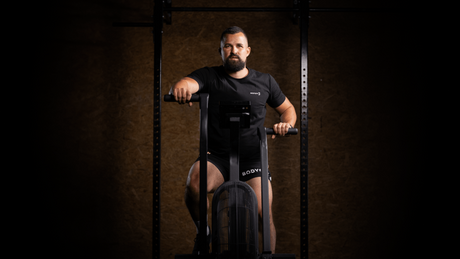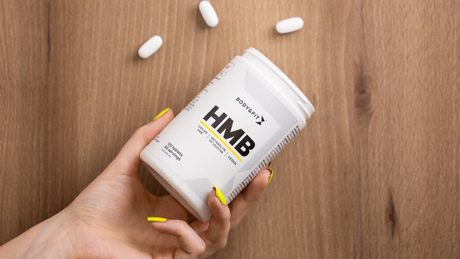Before we get into the blog, let me introduce myself: my name is Shelly Wubbe, and I am a personal trainer and online fitness coach. Today, as part of my ‘Train with Shelly’ series in collaboration with Body&Fit, I’ve put together the top things to keep in mind when trying to build muscle. I’m an expert in physique transformations and have spent over 5 years working with my clients on a wide range of different body shapes and goals. I have extensively studied this subject as well, with a Master’s degree in Human Movement Sciences and am always learning more from my clients along the way.
In this blog, I am going to tell you how muscle growth and hypertrophy works, and how to achieve these in the best possible way. Also, we’ll look at important factors to keep in mind when trying to build muscle, and finally I’ll give you some practical tips. At the end, enjoy a complete 4-day workout plan that you can follow, along with a nutrition plan.
Let’s talk muscle growth, toning, muscle gains and hypertrophy
Muscle growth, toning, hypertrophy… In the end, they all mean the same thing: increasing the size of your muscles. When people start to work out, growing muscle is often the main goal. Yet it still varies; where one person wants a bigger chest and more biceps, someone else wants to grow their glutes and tone their legs, and yet another person wants to become a professional bodybuilder. These are all very different goals, but they all have common ground. Namely, in order to achieve these intended goals, it is necessary to grow your muscles.
When we start with strength training as a beginner, chances are great that you will experience an intense amount of muscle soreness. It’s often thought that this amount of muscle soreness equals effective training and therefore also leads to muscle growth. However, this is untrue. The same goes for getting a ‘pump’ after training.
So, what exactly is important for muscle growth?
Training for muscle growth
If muscle soreness and a good ‘pump’ are not indicators for effective training, how can you train for muscle growth? To answer this, it’s important to understand the three main muscle hypertrophy principles:
Mechanical tension and muscle growth
This is the first, and probably the most important, contributor to muscle growth. Mechanical tension refers to the tension on certain muscle fibres as a reaction to a stimulus (training). When you lift weights through a full range of motion, the muscles are placed under a combination of passive and active tension, since they are lengthened and shortened. As mechanical tension is the main driver for muscle growth, it is important to increase it over time by increasing the load of the weight, the number of reps or the number of sets.
Metabolic stress in weight training
Think about that burning feeling you get when you know you are really targeting a muscle. This is caused by metabolic stress. Where mechanical tension fatigues the muscle fibres, metabolic stress is the accumulation of waste products, such as lactate and creatine, also causing that burning sensation.
Metabolic stress can be achieved by performing high reps, as it fatigues the muscle. It’s also often seen as a contributor for muscle growth, although the impact on muscle growth is limited as far as current research goes. Training volume remains the main driver for muscle growth. Volume is a measure of the total amount of activity or work that you perform in one go.
Muscle damage and muscle hypertrophy
The damage done to your muscles as a result of training is a by-product of the training itself. We can’t do strength training without causing muscle damage, so how much muscle damage contributes to muscle hypertrophy? As far as we know, muscle damage is needed to repair, adapt and get stronger. However, muscle damage should not be the main goal to building muscle mass. Too much muscle damage can negatively influence hypertrophy because it breaks down your muscle. So, next to a solid training plan, always ensure adequate recovery — usually experienced as ‘rest days’ or days where the exercise targets different areas, or is considered ‘easy’.
Explaining progressive overload in muscle growth
The three principles of training for muscle growth show that there needs to be a certain stimulus placed on the muscle in order to make it stronger and grow. However, placing that stimulus only once on your muscles will not lead to a great effect. This is where progressive overload comes in.
Building muscle mass only takes place after training, during recovery. In this period, your body will repair your muscle fibres and help them adapt to the stimulus. The result? Bigger and stronger muscles.
When you challenge your muscles again in the next workout, this time a little more than last time, the same process is restarted. In this way, building muscle mass is a chain of stimuli (the training itself) and recovery (the rest time between training sessions). This is known as progressive overload.
Progress is essential for progressive overload. You must give a greater stimulus to your body in order to let it adapt. This does not mean that you should do more every training session, but it is important that you do this over time. If you try to achieve this as quickly as possible, chances are you may injure yourself and then it will only take longer.
My advice is to always take your time to build muscle, think about several months or even years. Building muscle mass is a slow process, but it is definitely worth it.
So, what about nutrition in muscle hypertrophy?
If you want to build muscle, nutrition is another important factor next to training. Your body needs sufficient food to be able to gain additional muscle mass. A caloric surplus (eating more calories than you burn) can help you to do this more effectively.
We must eat enough to achieve the right effect, not to aimlessly stuff ourselves in the hope that everything is used for muscle mass. Some of our calories will also go towards other processes in the body, such as fat storage.
Eating a small number of extra calories per day (e.g., 250-400 calories depending on the individual) is sufficient to gain mass without gaining a lot of fat. The main components to gaining muscle mass are:
Eating more calories to build mass
As mentioned earlier, the most effective way to gain muscle mass is to eat more calories than you burn. A caloric surplus of 5-15% per day is for most people a good starting point to lean bulk (build lean muscle mass). In some cases, it can be necessary to up the calories more in order to achieve the desired effect, this also depends on your own body type and metabolism.
Increasing your protein intake for bulking
As muscles are built from proteins, we need to consume sufficient protein in our diets. 1.6- 2g of protein per kg of body weight per day seems to be an optimal range for most individuals.
Drinking water to improve muscle tone
A well-hydrated muscle grows faster. This is due the fact that the water in your cells help create an environment where processes your muscles need to grow, like protein synthesis, can take place more easily.
Working out to build muscle
Muscles need to receive a stimulus in order to get bigger and stronger — that bicep curl, leg press or pull up.
Which are the best supplements for muscle gain?
Supplements are not a necessity to gain muscle mass, but they can help make the process easier and more effective. Some of my favourite supplements for hypertrophy are:
Creatine
Creatine is one of the most researched and widely used supplements. And rightly so, because it can help you train with more strength and recover faster. It can also help with your muscle hypertrophy. I use creatine monohydrate.
Whey protein
If you want to consume sufficient protein, whey protein might be worth considering. Your body needs protein for muscle hypertrophy, especially around your training, so consuming a whey protein shake can increase protein synthesis and therefore help you gain muscle mass. My favourite is the Whey Perfection Salted Caramel.
Shelly’s training plan to help build muscle
It’s now time to put what we’ve learned into practice, hit the gym and start putting some stressors on those muscles.
4 days — upper-lower split
Day 1: Upper body
|
Exercise |
Sets x reps |
|
Cardio of choice |
10 min |
|
3 x 5-8 |
|
3 x 12-15 |
|
3 x 8-12 |
|
3 x 8-12 |
|
3 x 8-12 |
|
3 x 8-12 |
|
3 x 8-12 |
Day 2: Lower body
|
Exercise |
Sets x reps |
|
Cardio of choice |
10 min |
|
3 x 6-8 |
|
3 x 8-12 |
|
3 x 8-12 |
|
3x 12-15 |
|
3 x 8-12 |
|
4 x 10-12 |
Day 3: Upper body
|
Exercise |
Sets x reps |
|
Cardio of choice |
10 min |
|
3 x 8-12 |
|
3 x 8-12 |
|
3 x 12-15 |
|
3 x 8-10 |
|
3 x 12-15 |
|
3 x 12-15 |
|
3 x 12-15 |
Day 4: Lower body
|
Exercise |
Sets x reps |
|
Cardio of choice |
10 min |
|
3 x 5-8 |
|
4 x 8-12 |
|
3 x 12-15 |
|
3x 8-12 |
|
4 x 12-15 |
|
4 x 12-15 |
Shelly's muscle growth nutrition plan
The calories your body needs are based on various factors such as length, weight, activity level and daily activity. Individuals have different needs in terms of calories to have a caloric deficit or surplus — depending on their body type and metabolism. Therefore, no calorie counts are given in this meal plan. Portions can always be adjusted based on your own body’s needs.
Breakfast
- 3 whole eggs
- 2 slices of bread
- 50g tomatoes
- Handful of spinach
- Body&Fit Smart Cooking Spray
Suggested supplements:
Lunch
- 70g whole wheat pasta (you can also try Body&Fit Smart Pasta)
- 20g pesto
- Parmesan cheese
- 100g chicken
Snack
- 30g Body&Fit Whey Perfection
- 30g Body&Fit Ultra-Fine Oats
- 20g Body&Fit Natural Peanut Butter
- 1 banana
- 300ml milk
Dinner
- 200g salmon
- 300g broccoli
- 300g potatoes
- Body&Fit Smart Cooking Spray
Snack
- 500ml Quark
- Body&Fit Natural Flavouring Drops
- 50g Muesli
- 200g Raspberries
About Shelly Wubbe
Shelly is a personal trainer and online coach with a background in human movement sciences. She has learned the craft of fitness coaching from a variety of perspectives, including coaching herself to a competition-ready physique; coaching others with a range of goals and skill levels; and completing multiple courses on exercise and nutrition.
“Body&Fit has supported me from the very beginning of my health and fitness journey. There is still a lot to learn in the world of sports nutrition, and it gives me great pleasure to pass on my knowledge to you, the Body&Fit community of go-getters and fit seekers. I’ll be back with more ‘Train with Shelly’ articles soon, so keep a look out for those and make sure to follow me and check out my website for even more advice, workouts and inspiration. You can also keep an eye out for my workout, recipe and advice content on social @bodyandfit_official”.
Instagram: @ShellyWubbe
Website: Shelly Wubbe | Strength training and mindset coach for women (growcoach.nl)



